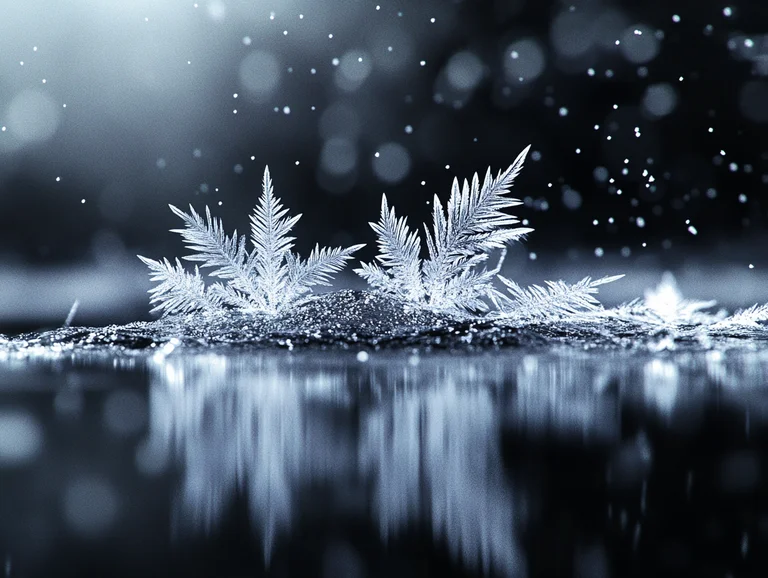- Basic Concepts
What is Freezing Point?
The freezing point, the temperature at which a liquid turns into a solid, is more than just water freezing at 0°C. In this article, we'll explore the science behind it, how factors like purity and pressure alter it, and how this knowledge impacts our lives, from winter roads to food preservation, with clear examples.
Cooling Maestro
Co-Founder

The freezing point, the temperature at which a liquid becomes a solid, is much more than just the moment water turns to ice at 0°C. This fundamental physical property is a fascinating transformation that occurs at the molecular level and directly impacts many aspects of our lives. So, what exactly compels a liquid to freeze, and why isn’t this temperature always constant? In this article, we’ll explore the science behind the freezing point, the factors that influence it, and its practical applications.
The Science Behind Freezing Point: The End of the Molecular Dance
In a liquid, molecules are in constant motion, sliding past each other, rotating, and vibrating. As a substance is cooled, the kinetic energy of these molecules decreases, and their movement slows down. When the temperature reaches the freezing point, the forces of attraction between the molecules overcome their energy to move about randomly.
At this stage, the molecules slow down enough to lock themselves into a regular, fixed pattern called a crystal lattice. This is the moment the liquid transforms into a solid. Interestingly, the temperature remains constant until the liquid has completely solidified. This is because a form of energy known as the “latent heat of fusion” is released during this phase change, and this energy release prevents the temperature from dropping further.
Factors That Affect the Freezing Point
Although the freezing point of pure water is accepted as 0°C (32°F) at standard atmospheric pressure, this value is not absolute. Two main factors can significantly alter the freezing point:
1. Purity (Freezing Point Depression)
When another substance, like salt or sugar, is added to and dissolved in a liquid, the freezing point of the pure liquid drops. This phenomenon is called freezing point depression.
- Why It Happens: The particles of the dissolved substance (the solute, e.g., salt) get in between the liquid molecules (the solvent, e.g., water). These “foreign” particles disrupt the ability of the water molecules to form an orderly crystal lattice. For the system to freeze, the temperature must be lowered even further, slowing the molecules down more to overcome this disruption.
- Everyday Example: This is why salt is sprinkled on icy roads in the winter. Salt lowers the freezing point of ice to well below 0°C (for instance, down to -9°C or -15°C). This causes the ice to melt even when the air temperature is below freezing, keeping the roads safe. The antifreeze used in cars operates on the same principle; it lowers the freezing point of the water in the radiator, preventing engine damage in the coldest weather.
2. Pressure
The effect of pressure on the freezing point is generally less dramatic than that of purity, but it is still important. For most substances, as pressure increases, the freezing point also increases. However, water is the most famous exception to this rule.
- Why Water is Different: Water is one of the few substances that expands when it freezes (which is why ice floats). When high external pressure is applied to water, this expansion is hindered. For the system to freeze (i.e., to expand), the temperature must drop even lower. Therefore, as the pressure on water increases, its freezing point slightly decreases.
Practical Applications of the Freezing Point
The concept of the freezing point shapes our world in more ways than we might think:
- Food Preservation: Freezing food stops the activity of bacteria and microorganisms by turning the water inside them into ice, allowing food to be preserved for much longer.
- Metallurgy: The fact that different metals have different freezing points makes it possible to create alloys (like steel or bronze).
- Climate Science: The saltiness of ocean water causes it to freeze at a lower temperature than fresh water (around -1.9°C). This is a critical factor affecting the formation of polar ice caps and global climate cycles.
- Medicine: In techniques like cryosurgery, substances with extremely low freezing points, such as liquid nitrogen, are used to destroy abnormal tissues by freezing them.
In conclusion, the freezing point is far more than a simple line on a thermometer. It is a fundamental law of nature that governs the molecular behavior of matter, keeps our roads safe in winter, and allows us to keep our food fresh.
Let's Design the Perfect Solution for Your Project Together
Let us analyze your needs to design and implement a custom, energy-efficient, and durable refrigeration system for you. Contact us to meet our expert team and get a personalized quote for your project.
Customer Satisfaction
For us, success is more than just a delivered project; it's a long-term, trust-based partnership fortified by our after-sales support.
Field Experience
With over 15 years of industry experience, we craft the most precise and efficient solutions for every detail of your project.
Sustainability
Boost your business's profitability and competitive edge through our focus on Eco-Friendly and Energy-Efficient manufacturing.